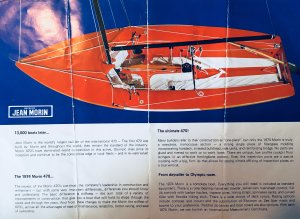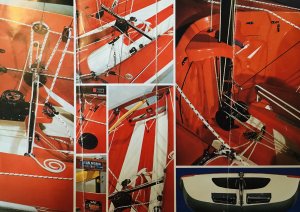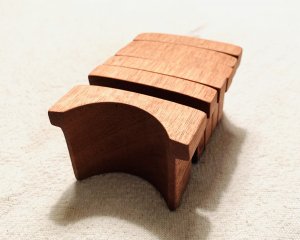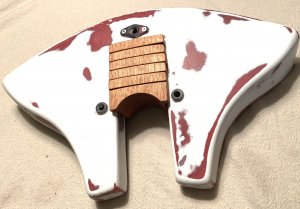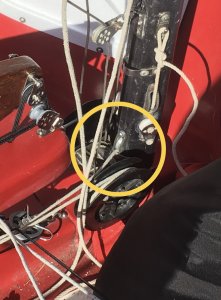Having never used a spinnaker before, I went to a (free) workshop where instructors were outlining the basics of setting, tuning, trimming, jibing, and taking down the spinnaker. Everything was taught on a Thistle, which we later went and sailed and actually flew the spin. One of the crucial points when raising the spin (on a Thistle) was to lower the jib. You mentioned earlier that the jib on a 470 stays up all the time -- so do you sail the jib under the spin the same way as you would without the spin?
Navigation
Install the app
How to install the app on iOS
Follow along with the video below to see how to install our site as a web app on your home screen.

Note: This feature currently requires accessing the site using the built-in Safari browser.
More options
You are using an out of date browser. It may not display this or other websites correctly.
You should upgrade or use an alternative browser.
You should upgrade or use an alternative browser.
470 Questions
- Thread starter US 1214
- Start date
LaLi
Well-Known Member
Pretty much, yeah. As a rule of thumb though, it's better to sheet it too loose than too tight. On a reach, sheet it so the lower telltails are flying (or the luff is nearly flapping a third of the way up); the top of the sail will invert but that's not a problem. On a run, just keep both jib sheets loose enough so that the sail doesn't obstruct the air flow too much. You can actually use the jib as a big telltale: if it wants to move to windward, then you're sailing too low in most conditions and situations. You may also want to tie the stopper knots on the sheets so that the clew can't go forward of the luff (so you don't get the jib wrapped around itself).do you sail the jib under the spin the same way as you would without the spin?
_
LaLi
Well-Known Member
You can buy telltail sets, and you can make your own from wool thread (not too fluffy) and pieces of spinnaker tape. As for placement, find and look at pictures of top 470 sailors and their setups. (I will be on my phone for the next two weeks, and have a hard time with any links here.)
I've never seen telltails that would have actually been too heavy. Many have been located too close to a seam, though, and gotten repeatedly stuck.
_
I've never seen telltails that would have actually been too heavy. Many have been located too close to a seam, though, and gotten repeatedly stuck.
_
Still alive  . Been sailing the 470 an awful lot, even passed a Hobie 16 on a reach (though they flew by us on every other point of sail
. Been sailing the 470 an awful lot, even passed a Hobie 16 on a reach (though they flew by us on every other point of sail  ). We have only flown the Spinnaker a few times due to complexity and pure chaos it creates for us newbies to get it up/down and filled properly. Does the spinnaker pole attach to the guy in a fixed location, or should the guy be able to slide through the pole?
). We have only flown the Spinnaker a few times due to complexity and pure chaos it creates for us newbies to get it up/down and filled properly. Does the spinnaker pole attach to the guy in a fixed location, or should the guy be able to slide through the pole?
P.S.
Thanks for all the help above, it’s been tremendously helpful in preparing the boat for the summer .
.



(Yes I know that the trapeze isn’t properly fastened, there aren’t battens in the sails, and I haven’t added tell tails yet)
 . Been sailing the 470 an awful lot, even passed a Hobie 16 on a reach (though they flew by us on every other point of sail
. Been sailing the 470 an awful lot, even passed a Hobie 16 on a reach (though they flew by us on every other point of sail  ). We have only flown the Spinnaker a few times due to complexity and pure chaos it creates for us newbies to get it up/down and filled properly. Does the spinnaker pole attach to the guy in a fixed location, or should the guy be able to slide through the pole?
). We have only flown the Spinnaker a few times due to complexity and pure chaos it creates for us newbies to get it up/down and filled properly. Does the spinnaker pole attach to the guy in a fixed location, or should the guy be able to slide through the pole? P.S.
Thanks for all the help above, it’s been tremendously helpful in preparing the boat for the summer
 .
. (Yes I know that the trapeze isn’t properly fastened, there aren’t battens in the sails, and I haven’t added tell tails yet)
LaLi
Well-Known Member
The first thing I thought seeing the first picture was "get some battens... at least a top batten!" Heh. But great to see that boat on the water!
Yes, the guy has to slide through the pole end fittings (it would be a pain if it didn't). You should still fly the spinnaker and adjust the pole height so that the pole end practically touches the sail.
The trapeze system looks fine, you just want to shorten the wires a bit. You can see in the last picture that the crew will have a hard time coming in when the handle is that low (and btw he's holding it with the wrong hand).
Would be nice to see what the tillercam has recorded!
_
Yes, the guy has to slide through the pole end fittings (it would be a pain if it didn't). You should still fly the spinnaker and adjust the pole height so that the pole end practically touches the sail.
The trapeze system looks fine, you just want to shorten the wires a bit. You can see in the last picture that the crew will have a hard time coming in when the handle is that low (and btw he's holding it with the wrong hand).
Would be nice to see what the tillercam has recorded!
_
LaLi
Well-Known Member
I don't think a vice would work because you want to squeeze the crimp from all directions at once. Ask at your club if someone has the right tools, or where they get their wire work done.
_
_
Battens - would 420 batten kit suffice? I would like to just purchase a bunch of stock (then I could batten the Holder 14’s sail as well (which may not do much good since that sail is the consistency of a black garbage bag  )). How flexible should a batten be? Do all battens in the sail have the same amount of flexibility?
)). How flexible should a batten be? Do all battens in the sail have the same amount of flexibility?
 )). How flexible should a batten be? Do all battens in the sail have the same amount of flexibility?
)). How flexible should a batten be? Do all battens in the sail have the same amount of flexibility?LaLi
Well-Known Member
The 420 main has four battens (the 470 has only three), and they most likely don't fit into a 470 main (probably too short). You better order a real 470 set of battens from North or Ullman. I have a hard time posting links until Monday, but I'll see what I can find then.
Broke my tiller extension yesterday.
Released the main in a gust and didn’t get it in quick enough, ended up dumping my crew (who was on the trap) . Boat veered windward capsized then turtled
. Boat veered windward capsized then turtled  . Fortunately the boat very easily rights (this has happened many times before).
. Fortunately the boat very easily rights (this has happened many times before).
The only damage was a severed extension and an unhappy crew . Anyways, I was looking to make a new pole out of either fiberglass or aluminum (found on McMaster Carr).
. Anyways, I was looking to make a new pole out of either fiberglass or aluminum (found on McMaster Carr).
What’s the ‘proper’ length of the extension? I always thought that the pole was too short (especially when my toes are in the hiking strap and I’m sitting towards the bow over the traveler) - in this scenario, the pole no longer fits in my lap.
Released the main in a gust and didn’t get it in quick enough, ended up dumping my crew (who was on the trap)
 . Boat veered windward capsized then turtled
. Boat veered windward capsized then turtled  . Fortunately the boat very easily rights (this has happened many times before).
. Fortunately the boat very easily rights (this has happened many times before). The only damage was a severed extension and an unhappy crew
 . Anyways, I was looking to make a new pole out of either fiberglass or aluminum (found on McMaster Carr).
. Anyways, I was looking to make a new pole out of either fiberglass or aluminum (found on McMaster Carr). What’s the ‘proper’ length of the extension? I always thought that the pole was too short (especially when my toes are in the hiking strap and I’m sitting towards the bow over the traveler) - in this scenario, the pole no longer fits in my lap.
LaLi
Well-Known Member
I am out of touch with what people are using in the class nowadays, but a good general rule of thumb is to go for the longest stick that you can tack comfortably, with the outboard end of it near the mainsheet cleat when you're head to wind. So it depends on your tiller length, too. If you're making it yourself, you might want to set the rudder at a typical mid-tack angle and measure the joint-to-mainsheet distance, as a starting point.What’s the ‘proper’ length of the extension?
If you always swing the extension to the other side the other way (so it's pointing aft), then its length is a little less critical; just don't make it so long that it all too easily reaches the facial area of the crew in normal position

_
Roll tack with no crew? What does that look like?
I found myself sailing alone the majority of the time. Which is fun, especially on a reach where the boat planes easier. The problem is, I weigh significantly under the optimal, and can’t roll the boat significantly on tacks (jibes seem to roll easier).
The usual roll (as taught in the c420) was performed by syncing the crew and skipper movement across the hull. Sometimes the crew would move across the hull again to keep the boat flat after the tack. I usually use the main sheet between the boom and block as a handle (though I’m not sure if this is good practice).
I found myself sailing alone the majority of the time. Which is fun, especially on a reach where the boat planes easier. The problem is, I weigh significantly under the optimal, and can’t roll the boat significantly on tacks (jibes seem to roll easier).
The usual roll (as taught in the c420) was performed by syncing the crew and skipper movement across the hull. Sometimes the crew would move across the hull again to keep the boat flat after the tack. I usually use the main sheet between the boom and block as a handle (though I’m not sure if this is good practice).
LaLi
Well-Known Member
The skipper moves in the same way as with a crew. Of course, in lighter air the movement starts closer to the centreline, and ends there as well on the new tack, so you play part of the crew's role then.Roll tack with no crew? What does that look like?
I'm sure it's not - if you feel you need to grab something, try something more rigid, like the traveller track.I usually use the main sheet between the boom and block as a handle (though I’m not sure if this is good practice).
_
David Hughes
New Member
The red boat looks excellent. Well done! Battens for the #2 and #3 pockets are about 755-775mm. Class rules keep the pockets at 800mm. The top batten varies based on the type of main used. There are longer and shorter battens, but it doesn't mean that one sail is smaller than the other by much....just different theories. Top battens are usually about 1060mm. For tiller extensions, either go short (about 950mm) or long (1450mm) If you are in need of sails, let me know. There are some donation programs that make their way down from the Olympic team. Dave Hughes ([email protected])
David Hughes
New Member
Most boards do get scratches. However, there are shimming materials on the market to tape along the top and bottom of the centercase (this would be lengthwise to the hull). In the end, much of it depends on bolt tension. If the board is tight on land, then it will be too tight on the water. Ideally, the board wants to drop a little on land and, thus, will need a rope (or use the cunningham) to keep it in the case while ashore.
Most boards do get scratches. However, there are shimming materials on the market to tape along the top and bottom of the centercase (this would be lengthwise to the hull). In the end, much of it depends on bolt tension. If the board is tight on land, then it will be too tight on the water. Ideally, the board wants to drop a little on land and, thus, will need a rope (or use the cunningham) to keep it in the case while ashore.
Thanks! She’s all packed up for the season, won’t see water until next season
 . Now “bolt tension” is new... Is the “bolt” the boards pivot? This can’t be easily tightened on my boat as it is captured in glass on both sides.
. Now “bolt tension” is new... Is the “bolt” the boards pivot? This can’t be easily tightened on my boat as it is captured in glass on both sides. I’m a bit concerned about the boards mechanism (I won’t be able to post pictures for a while
 ). The original system relied on the tension in a segment of shock chord to bias the board either “up” or “down” - no in between. I wanted to change this so I have more control over the exposed foil surface in the water. The easiest way to accomplish that, I guess, would be to use two cam cleats that lock the boards control lines - that way, the board could be “up”, “down” or anywhere in between. Any thoughts?
). The original system relied on the tension in a segment of shock chord to bias the board either “up” or “down” - no in between. I wanted to change this so I have more control over the exposed foil surface in the water. The easiest way to accomplish that, I guess, would be to use two cam cleats that lock the boards control lines - that way, the board could be “up”, “down” or anywhere in between. Any thoughts? Thanks!
LaLi
Well-Known Member
David, Ryan's boat has no centreboard "bolt" in the sense of what the vast majority of 470s have - see posts #20, 21 and 23 in this thread. (It's actually somewhat similar to what I have on my Lightning.)In the end, much of it depends on bolt tension. If the board is tight on land, then it will be too tight on the water.
Yes it is. I assume you can adjust the tension on the screws that act as the bolt, but then of course you have to take the whole thing out of the centreboard case, and the effect is probably not the same anyway.Now “bolt tension” is new... Is the “bolt” the boards pivot?
NO CLEATS! You want to have complete control over the centreboard when the boat is upside down and you can't reach any cleats then. The only way to play is to rig a continuous "friction" system which is held taut by elastic. The top boats today have separate lines for uphaul and downhaul led to the side tanks but that would be overkill for your purposes. You won't need many new parts to build a simple working system.I’m a bit concerned about the boards mechanism (I won’t be able to post pictures for a while). The original system relied on the tension in a segment of shock chord to bias the board either “up” or “down” - no in between. I wanted to change this so I have more control over the exposed foil surface in the water. The easiest way to accomplish that, I guess, would be to use two cam cleats that lock the boards control lines - that way, the board could be “up”, “down” or anywhere in between. Any thoughts?
Thanks for the thanksDiscovered the “like button” today (hehe). Thanks for all the help!
 There used to be "dislike", "agree", "disagree", "informative" and "useful" buttons, too. I miss them.
There used to be "dislike", "agree", "disagree", "informative" and "useful" buttons, too. I miss them._
Spent all day retrieving my main halyard from inside the mast . It wasn’t just skied, it was tangled in the spinnaker halyard, the forestay, wrapped around internal fittings and stuck in foam (?) inside the mast  (though most the tangling and wrapping was probably from my efforts to retrieve it
(though most the tangling and wrapping was probably from my efforts to retrieve it  ). Ended up unstepping the mast and pulling it out completely (which was much more involved than I thought would be) and sent a fishing wire through (again not easy because it had to travel through foam (why is there foam in my mast?). Had to do it twice since the first time the internal lines became twisted and caused chafing on every system running through the mast.
). Ended up unstepping the mast and pulling it out completely (which was much more involved than I thought would be) and sent a fishing wire through (again not easy because it had to travel through foam (why is there foam in my mast?). Had to do it twice since the first time the internal lines became twisted and caused chafing on every system running through the mast.
Question: has anyone done this before? Is there any tricks to retrieving lines from within a mast?
Also, here’s some pictures of the boat currently. New finishes on the blades, new finish on the teak, fresh coat of paint (which is becoming seasonal), new centerboard gasket (no more stuffing a red noodle into the centerboard truck to stop water ), and finally a makeshift spinnaker bag made from an old sail bag, don’t have a picture of that yet.
), and finally a makeshift spinnaker bag made from an old sail bag, don’t have a picture of that yet.
Yes I know there’s no battens in the sails, been meaning to do that. Any good sources to purchase those?
Cheers
 (though most the tangling and wrapping was probably from my efforts to retrieve it
(though most the tangling and wrapping was probably from my efforts to retrieve it  ). Ended up unstepping the mast and pulling it out completely (which was much more involved than I thought would be) and sent a fishing wire through (again not easy because it had to travel through foam (why is there foam in my mast?). Had to do it twice since the first time the internal lines became twisted and caused chafing on every system running through the mast.
). Ended up unstepping the mast and pulling it out completely (which was much more involved than I thought would be) and sent a fishing wire through (again not easy because it had to travel through foam (why is there foam in my mast?). Had to do it twice since the first time the internal lines became twisted and caused chafing on every system running through the mast. Question: has anyone done this before? Is there any tricks to retrieving lines from within a mast?
Also, here’s some pictures of the boat currently. New finishes on the blades, new finish on the teak, fresh coat of paint (which is becoming seasonal), new centerboard gasket (no more stuffing a red noodle into the centerboard truck to stop water
 ), and finally a makeshift spinnaker bag made from an old sail bag, don’t have a picture of that yet.
), and finally a makeshift spinnaker bag made from an old sail bag, don’t have a picture of that yet. Yes I know there’s no battens in the sails, been meaning to do that. Any good sources to purchase those?
Cheers
Attachments
-
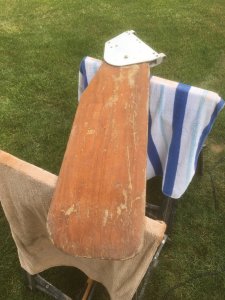 8354D64E-2675-4D06-A166-7BC98F82358E.jpeg1.1 MB · Views: 137
8354D64E-2675-4D06-A166-7BC98F82358E.jpeg1.1 MB · Views: 137 -
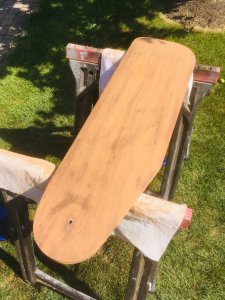 FD93ABCE-46C0-471D-95FF-96275281009F.jpeg1.3 MB · Views: 154
FD93ABCE-46C0-471D-95FF-96275281009F.jpeg1.3 MB · Views: 154 -
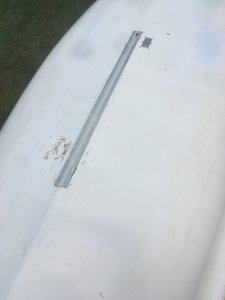 4110F814-AB12-4910-903C-8416C0E17E8B.jpeg404.5 KB · Views: 142
4110F814-AB12-4910-903C-8416C0E17E8B.jpeg404.5 KB · Views: 142 -
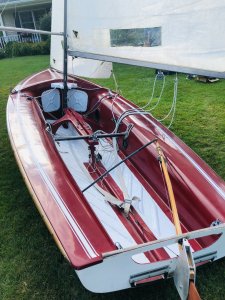 59DA874B-83F1-4899-9FD4-3FCBDCF643EF.jpeg1.2 MB · Views: 149
59DA874B-83F1-4899-9FD4-3FCBDCF643EF.jpeg1.2 MB · Views: 149 -
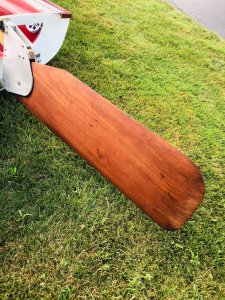 10DE6443-398B-4618-BC7D-0B82C6B40155.jpeg2.4 MB · Views: 147
10DE6443-398B-4618-BC7D-0B82C6B40155.jpeg2.4 MB · Views: 147 -
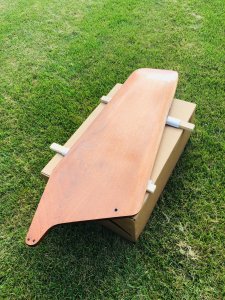 B2896CF7-AB1D-494E-AD8E-9041733697FA.jpeg2.3 MB · Views: 131
B2896CF7-AB1D-494E-AD8E-9041733697FA.jpeg2.3 MB · Views: 131 -
 B84BADE7-3343-4EE6-BD20-939C0BD01594.jpeg774.6 KB · Views: 140
B84BADE7-3343-4EE6-BD20-939C0BD01594.jpeg774.6 KB · Views: 140
LaLi
Well-Known Member
And then there's the red boat 
Nothing guarantees though that the lines & wires pass one another inside the mast the way they were intended! It's good however to tension all other halyards/lines (other than the one being installed) before threading another. It's easier, too, if you can hold the mast upright (or at least non-horizontal) while doing this. Second- and third-floor balconies have come in handy
_

It's possible that there was a class rule about that back in the day. Or some Frenchman thought it was a good idea.why is there foam in my mast?
Yes and yes! But it's never easy. One trick is to remove the mast heel fitting, let the halyard come out of the mast foot, feed a thin messenger line down from the exit hole so that it comes out of the mast foot as well, connect the two, and pull the free end of the messenger. This probably includes drilling out a few rivets, but so does removing things like exit blocks in order to have a bigger hole to catch whatever you want to come through. (Of course, if the exit blocks are integrated in the heel fitting, or otherwise very close to it, you don't even need the messenger.)has anyone done this before? Is there any tricks to retrieving lines from within a mast?
Nothing guarantees though that the lines & wires pass one another inside the mast the way they were intended! It's good however to tension all other halyards/lines (other than the one being installed) before threading another. It's easier, too, if you can hold the mast upright (or at least non-horizontal) while doing this. Second- and third-floor balconies have come in handy

What happened to the Harkens?a makeshift spinnaker bag made from an old sail bag
I'd contact David (see post #51 above). Or your closest North loft. (These guys should be able to help you: Milford, Connecticut | North Sails)Yes I know there’s no battens in the sails, been meaning to do that. Any good sources to purchase those?
_
Last edited:
David is having fun in the Olympic test event in Japan
LaLi
Well-Known Member
Probably is! After a disappointing 18th in the Worlds, he's going into the medal race, and extremely likely finishing the whole regatta, in fourthDavid is having fun in the Olympic test event in Japan

Ready Steady Tokyo
_
Bags arrived 
I’m currently replacing lines and sheets and straps with newer stuff (after episodes of hiking straps breaking and lines breaking in the mast ).
).
The original bags used a type of nylon (?) lashing hook to mount the bags, and mount the elastic to the hull. The same hooks were used to temporarily hold spinnaker sheets and other elastic throughout the boat.
I can’t find the style hook anywhere, so I’m looking at alternatives.
The pictures I have of the hooks are from the pamphlet that came with the boat. I posted them previously but I’ll post them here again since it’s relevant.

I’m currently replacing lines and sheets and straps with newer stuff (after episodes of hiking straps breaking and lines breaking in the mast
 ).
). The original bags used a type of nylon (?) lashing hook to mount the bags, and mount the elastic to the hull. The same hooks were used to temporarily hold spinnaker sheets and other elastic throughout the boat.
I can’t find the style hook anywhere, so I’m looking at alternatives.
The pictures I have of the hooks are from the pamphlet that came with the boat. I posted them previously but I’ll post them here again since it’s relevant.
Attachments
LaLi
Well-Known Member
Forget about the hooks. Screw the bags directly to the bulkhead, use an eyestrap or two on the side tank (depending on the flap configuration) and just holes in the mast gate for the elastics. The original setup seems to have simply connected the bags' aft inner corners, with no attachment to the mast gate, though. You might want to try that first. Take a good look again at post #19 for another example how to do this. The Harken bags probably aren't cut to any specific hull model, so they won't be a "perfect" fit anyway; you might want to tape them in place at first to test the exact positioning.
_
_
Chocks.
I threw together a set today. Are they still common practice on 420s and 470s? Where can I find “real” dimensions for chocks, tuning guide?
Boat is undergoing some upgrades and new finishes here and there (that is why the mast gate is in that condition in this picture ).
).
I threw together a set today. Are they still common practice on 420s and 470s? Where can I find “real” dimensions for chocks, tuning guide?
Boat is undergoing some upgrades and new finishes here and there (that is why the mast gate is in that condition in this picture
 ).
).Attachments
Last edited:
LaLi
Well-Known Member
In the 420 they're the only thing allowed. In the 470, no one's used them since the 1970sChocks.
I threw together a set today. Are they still common practice on 420s and 470s?

Their dimensions are right if they fit! Tuning in turn is right if the lower mast bend is right... In practice, for recreational sailing that means that when the rig is fully tensioned, you use enough chocks that they sit just snugly in place in both light and overpowered conditions; in medium wind you may want to straighten the mast with an extra chock or two. (And you may want to make one that's half as thick as those, for fine-tuning.)Where can I find “real” dimensions for chocks, tuning guide?
_
Back with pics! 
I’ve been busy refinishing and replacing worn lines (thanks Dave!). Ever since Dave helped me out with a sail, I figured I’d make the boat look just as good (thanks again!). (The current situation also gave me time to put energy into this project). This time the list included spin bags, red paint, and adding bushings to the centerboard.
Question for this time around: Mast rake; I think my mast is too vertical. The C420s had plenty of slack when not in tension. I don’t, the mast is almost in position when there is no load on it, I think my lazy forestay is too short. (I’m also missing my small chock).
Seems to be a bunch of 1970s 470s resurfacing here .
.
I think the trapeze handles are a bit high , but I’ll leave them until I have time again.
, but I’ll leave them until I have time again.
While the 470 has been getting work, I tried my hand at a Hobie 16.

I’ve been busy refinishing and replacing worn lines (thanks Dave!). Ever since Dave helped me out with a sail, I figured I’d make the boat look just as good (thanks again!). (The current situation also gave me time to put energy into this project). This time the list included spin bags, red paint, and adding bushings to the centerboard.
Question for this time around: Mast rake; I think my mast is too vertical. The C420s had plenty of slack when not in tension. I don’t, the mast is almost in position when there is no load on it, I think my lazy forestay is too short. (I’m also missing my small chock).
Seems to be a bunch of 1970s 470s resurfacing here
 .
.I think the trapeze handles are a bit high
 , but I’ll leave them until I have time again.
, but I’ll leave them until I have time again.While the 470 has been getting work, I tried my hand at a Hobie 16.
Attachments
-
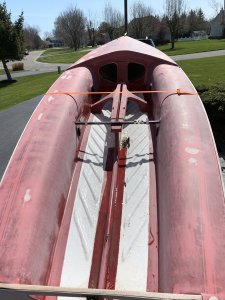 7783F442-F8FF-4D71-B244-97AF936649C8.jpeg909.3 KB · Views: 123
7783F442-F8FF-4D71-B244-97AF936649C8.jpeg909.3 KB · Views: 123 -
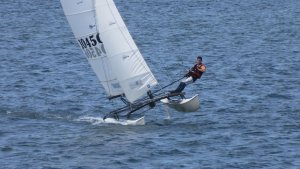 546F2989-29FA-45CF-A897-AB9228CBD281.jpeg339.3 KB · Views: 135
546F2989-29FA-45CF-A897-AB9228CBD281.jpeg339.3 KB · Views: 135 -
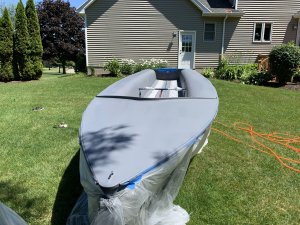 178A26FF-7A76-49E4-8314-D30794D98846.jpeg2.5 MB · Views: 125
178A26FF-7A76-49E4-8314-D30794D98846.jpeg2.5 MB · Views: 125 -
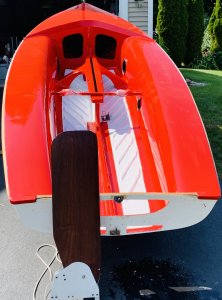 6203B80D-B105-4EE6-B30E-F92144F5D752.jpeg763.7 KB · Views: 127
6203B80D-B105-4EE6-B30E-F92144F5D752.jpeg763.7 KB · Views: 127 -
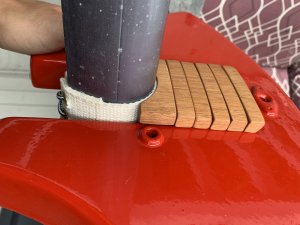 00A654B5-BDC7-44C1-9537-D3104D6BE686.jpeg1.1 MB · Views: 129
00A654B5-BDC7-44C1-9537-D3104D6BE686.jpeg1.1 MB · Views: 129 -
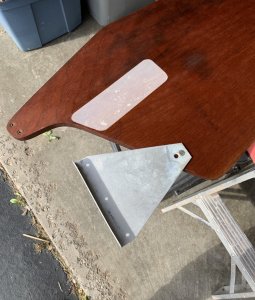 DF4639D8-E9A2-49F4-83E1-EE9BB8405127.jpeg1.1 MB · Views: 122
DF4639D8-E9A2-49F4-83E1-EE9BB8405127.jpeg1.1 MB · Views: 122 -
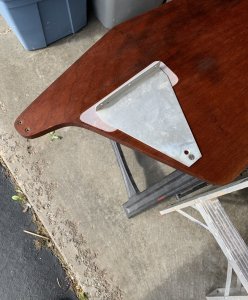 8526276D-87A7-4CCE-A9D8-79C34CF5D2AB.jpeg1.2 MB · Views: 127
8526276D-87A7-4CCE-A9D8-79C34CF5D2AB.jpeg1.2 MB · Views: 127 -
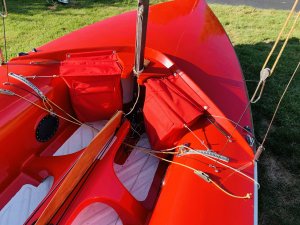 79BB3ACE-2C97-4AF3-AA86-5EA28BF94B74.jpeg1.5 MB · Views: 147
79BB3ACE-2C97-4AF3-AA86-5EA28BF94B74.jpeg1.5 MB · Views: 147 -
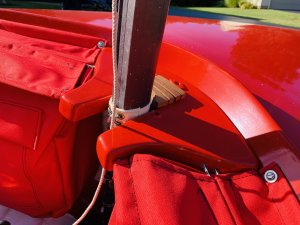 F75A3226-A5F4-4684-9AA4-C6649B51EA45.jpeg1.4 MB · Views: 145
F75A3226-A5F4-4684-9AA4-C6649B51EA45.jpeg1.4 MB · Views: 145 -
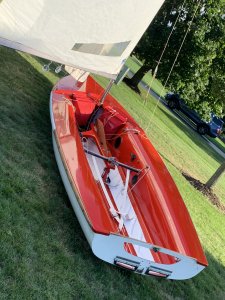 D942603A-7577-43E9-A0B4-E780963A0F15.jpeg1.2 MB · Views: 128
D942603A-7577-43E9-A0B4-E780963A0F15.jpeg1.2 MB · Views: 128 -
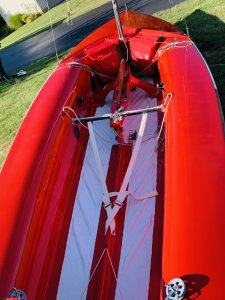 FF863E3E-A7E7-4E61-A12D-AADE8AE78712.jpeg760.6 KB · Views: 133
FF863E3E-A7E7-4E61-A12D-AADE8AE78712.jpeg760.6 KB · Views: 133 -
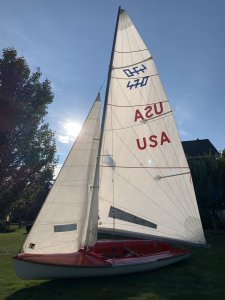 BAC0EECD-E7EF-4456-AA02-B2F912F69D58.jpeg753.3 KB · Views: 143
BAC0EECD-E7EF-4456-AA02-B2F912F69D58.jpeg753.3 KB · Views: 143 -
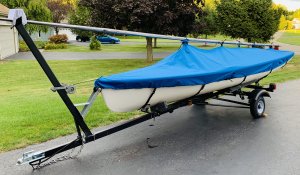 27915398-68FB-4759-A985-CE9B1565C33F.jpeg2.9 MB · Views: 139
27915398-68FB-4759-A985-CE9B1565C33F.jpeg2.9 MB · Views: 139
LaLi
Well-Known Member
Back with pics!
 Oh my, that's brilliant... quite literally! Extra points for the perfectly matching spinnaker bags
Oh my, that's brilliant... quite literally! Extra points for the perfectly matching spinnaker bags  Really nice to hear that David has been helping you
Really nice to hear that David has been helping you 
Just read what I've told to the other guys with old boatsQuestion for this time around: Mast rake; I think my mast is too vertical. The C420s had plenty of slack when not in tension. I don’t, the mast is almost in position when there is no load on it, I think my lazy forestay is too short.
 In short, measure the mast foot position (if you haven't already done it) so that it's at least 3055 millimetres from the transom (around 3100 is good), and then adjust the forestay length so that the mast comes almost halfway out of the mast gate. The "jibless" rake should look like this (the first picture!) then. The forestay should in principle be lengthened with an extra piece of wire, but you can use rope to get the length right (and even go sailing with it).
In short, measure the mast foot position (if you haven't already done it) so that it's at least 3055 millimetres from the transom (around 3100 is good), and then adjust the forestay length so that the mast comes almost halfway out of the mast gate. The "jibless" rake should look like this (the first picture!) then. The forestay should in principle be lengthened with an extra piece of wire, but you can use rope to get the length right (and even go sailing with it).After that you can start actually tuning the rig

They are! Trapezing styles improved fast in the late 70s, and along with that the handles went higher - but not that high! As I may have said earlier, the optimal height is somewhere just above the gooseneck when you pull the trapeze wire against the mast - maybe one third of the way to the pole ring. The exact "perfect" height is determined by how tall the crew is (arm length really), and personal style and preference.I think the trapeze handles are a bit high
Cotton hiking straps? Well, all fibre in the past was natural... but not in the 70s anymore (yeah, change them)!Also made new hiking straps.
Although, might swap these out with nylon soon since the material just came in. I trust nylon much better than cotton (was cotton original?).
_
Spinnaker halyard system: (I don’t have new pics for this one)
My spinnaker halyard runs to the bottom of the mast, but the block that allows it to exit the mast is partially blocked by the jib and boom vang tensioner (whatever that ancient winch-like system is called). Meaning, the line cannot cleat to a fitting on the centerboard trunk, where nearly all cleats are, without passing through another block first.
What kind of system was originally used on these kinds of boats?
Is there a modern system that’s simpler?
Also, currently I’m using a jurry-rigged 2:1 downhaul that I would like to replace properly. Have any insight there?
Went sailing for the first time (on the 470) this season! The boom is a lot higher than I remembered it being, even with the mast raked all the way back with the chocks. Or maybe I’m just used to the low boom on the Hobie. I’m starting to look at these finer adjustments (maybe boom height isn’t a fine adjustment ).
).
My spinnaker halyard runs to the bottom of the mast, but the block that allows it to exit the mast is partially blocked by the jib and boom vang tensioner (whatever that ancient winch-like system is called). Meaning, the line cannot cleat to a fitting on the centerboard trunk, where nearly all cleats are, without passing through another block first.
What kind of system was originally used on these kinds of boats?
Is there a modern system that’s simpler?
Also, currently I’m using a jurry-rigged 2:1 downhaul that I would like to replace properly. Have any insight there?
Went sailing for the first time (on the 470) this season! The boom is a lot higher than I remembered it being, even with the mast raked all the way back with the chocks. Or maybe I’m just used to the low boom on the Hobie. I’m starting to look at these finer adjustments (maybe boom height isn’t a fine adjustment
 ).
).Attachments
LaLi
Well-Known Member
Oh, I had forgotten that you have the rollers for the jib halyard and the vang (that's what I've called them and everyone has understood what I meant). I had them on my 1980 Fountaine Pajot; changed the vang almost right away to a block system, and did the same to the jib halyard a year later (although I have to admit that the memories are quite hazy by nowMy spinnaker halyard runs to the bottom of the mast, but the block that allows it to exit the mast is partially blocked by the jib and boom vang tensioner (whatever that ancient winch-like system is called). Meaning, the line cannot cleat to a fitting on the centerboard trunk, where nearly all cleats are, without passing through another block first.
What kind of system was originally used on these kinds of boats?
Is there a modern system that’s simpler?
 ) I think it was a "French" thing, and the majority never used it for the vang, Many more used it for the jib halyard, but even that was passé by the late 1980s.
) I think it was a "French" thing, and the majority never used it for the vang, Many more used it for the jib halyard, but even that was passé by the late 1980s.We could have a long talk about the mechanics of the roller system itself, but that wouldn't solve the problem at hand. One quick fix would be an additional single block for the spinnaker halyard above the exit block to lead the line over the roller attachment; another would be to simply cut a notch to the stainless attachment plate. Even then the halyard line may still chafe against the vertically-running part of the vang wire, so a long-term solution would take the halyard somewhere else, out of the way. What's the cheek block on the mast for? Is there another one on the other side?
(By the way, I think that the vang block on the mast was intended to be attached to that horizontal eyestrap.)
With "downhaul", do you mean main cunningham? It's not that important of an adjustment (you actually tension it in overpowered conditions only), but a 4:1 is still nice (and standard). Typically you'd have a 2:1 at the cunningham eye (deadended at the gooseneck), another 2:1 along the centreboard case, and a cleat on top of the case.Also, currently I’m using a jurry-rigged 2:1 downhaul that I would like to replace properly. Have any insight there?
Well... boom height is largely dictated by mast rake, which is a major tuning variable. Done any rake/tension/bend measurements yet?Went sailing for the first time (on the 470) this season! The boom is a lot higher than I remembered it being, even with the mast raked all the way back with the chocks. Or maybe I’m just used to the low boom on the Hobie. I’m starting to look at these finer adjustments (maybe boom height isn’t a fine adjustment).
_
_
[/QUOTE]
That is my next question . Figured I would get everything properly rigged first.
. Figured I would get everything properly rigged first.
[/QUOTE]
rake/tension/bend measurements yet?
That is my next question
 . Figured I would get everything properly rigged first.
. Figured I would get everything properly rigged first.